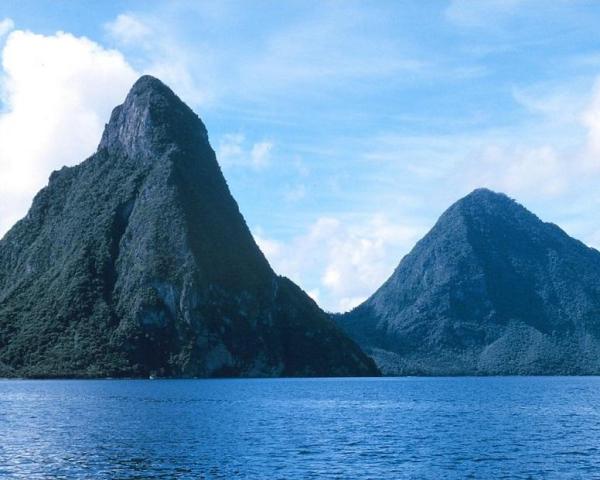One of the attractions of St. Lucia is snorkeling in the crystal clear waters of the Caribbean Sea. Read on to learn some interesting and fun facts about St. Lucia.
Facts About St. Lucia
St Lucia is the second largest of the Windward Islands located in the eastern Caribbean Sea. The island was created because of volcanic activity and is 43 km (27 miles) long and 23 km (14 miles) wide. Orchids and several other exotic plants grow wild in the lush rainforests of this island country. In recent years, St. Lucia has mainly been engaged in the export of bananas, clothing, vegetables, cacao and coconuts. In the past, St. Lucia’s biggest cultivation was of sugarcane, which was replaced by the cultivation of banana during the mid 1960s. It also has a strong tourism and fishing industry giving strength to this island nation’s economy. However, the government of St. Lucia has often had to grapple with some long standing problems of unemployment and drug-related crime. In 1940, before being included into the Windward Islands group, St. Lucia was administered as a part of the British Leeward Islands. It was a participant in the Federation of the West Indies from 1958 to 1962 and became one of the six self-governing West Indies Associated States in 1967.

Image: By Dr. Anthony R. Picciolo, NOAA NODC (http://www.photolib.noaa.gov) [Public domain], via Wikimedia Commons
Interesting And Fun Facts About St. Lucia
- St. Lucia is situated in the Caribbean Sea, as part of the Lesser Antilles, with its total area covering 616sq km.
- The closest islands neighbouring St Lucia are St Vincent to the south, and Martinique, to the north.
- The year-round temperature in St Lucia remains in the average range of about 27ºC (80ºF).
- Castries, the capital city of St Lucia, is actually located in a flood gut region. Interestingly, Castries has been built on a reclaimed land mass.
- St. Lucia, divided into 11 quarters, is estimated to have a population of almost 170,000.
- The East Caribbean dollar (EC$) is the national currency of St. Lucia.
- The recorded literacy rate of St Lucia shows about 67 percent of the population to be literate.
- The average life expectancy of the people of St. Lucia is around 72 years.
- Jacquot, or the St. Lucia Parrot, is a bird native only to these islands. It is the national bird of St. Lucia, and its scientific name is Amazona Versicolor.
- St. Lucia was known as the Island of the Iguanas by the Amerindian Arawak and Carib people who are known to have been among the earliest settlers here.
- At 950 m (3,117ft), Mount Gimie is the highest point on this island nation of St. Lucia.
- Both France and England continuously struggled to establish sole control over St Lucia throughout the 17th and early 18th centuries. In the bargain, this island nation changed hands nearly 14 times.
- Around the year 1600, the Dutch were the first to built Vieux Fort (or the old fort).
- In 1746, the town of Soufriere was built, under French administration.
- In 1814, St Lucia was surrendered to the United Kingdom, and came under British rule.
- On 1st March, 1967, the island nation of St Lucia became self-governing in internal affairs.
- "The Land, The People, The Light" was coined as the national motto of St. Lucia when it obtained total independence from England on 22nd February, 1979.
- “Sons and Daughters of Saint Lucia” is the national anthem of St Lucia. Penned by Charles Jesse, it has been set to music by Leton Felix Thomas.
- St Lucia continues to be a current member of the Commonwealth of Nations.
- The Honourable Stephenson King, born in Castries, is the current Prime Minister of Saint Lucia.
- Sir Arthur Lewis, who was awarded the Nobel Prize for Economic Sciences in 1979, was born in St Lucia in 1915.
- Derek Walcott, who was awarded the Nobel Prize for Literature in 1992, was born in Castries in 1930.
- The Pitons - Gros Piton and Petit Piton - are twin volcanic peaks that rise from the sea. These marvelous volcanic monuments have contributed in a big way to making St Lucia very famous.
- In 2004, the Pitons Management Area containing much of a collapsed stratovolcano known as the Soufriere Volcanic Centre, became a World Heritage Site.
- Sadly, hurricane Lenny left a lot of damage in its wake when it hit St Lucia in November 1999. The loss was estimated at around seventeen thousand East Caribbean dollars.
- The rules for driving in St Lucia officially state that roads should be approached from the left hand side.
- The Voice, The Star, The St Lucia Mirror, The Crusader and One Caribbean are some of the main newspapers of St Lucia.
See also
More from iloveindia.com
- Home Remedies | Ayurveda | Vastu | Yoga | Feng Shui | Tattoos | Fitness | Garden | Nutrition | Parenting | Bikes | Cars | Baby Care | Indian Weddings | Festivals | Party ideas | Horoscope 2015 | Pets | Finance | Figures of Speech | Hotels in India : Delhi | Hyderabad | Chennai | Mumbai | Kolkata | Bangalore | Ahmedabad | Jaipur
- Contact Us Careers Disclaimer Privacy Policy Advertise With Us Lifestyle Sitemap Copyright iloveindia.com. All Rights Reserved.







